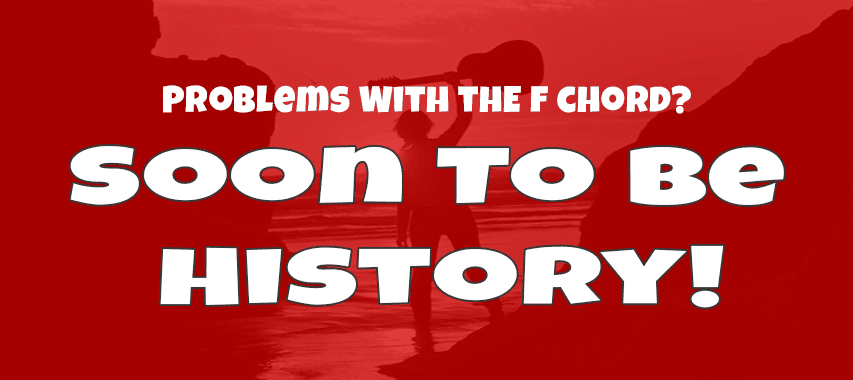
Updated January 2020
Every student I have come across has struggled with the F chord... including myself in the beginning.
The good news is there's a much easier way. In this step-by-step learning process you are going to play a simple form of the F guitar chord that will get you up and running in no time.
Then I'll show you how to use this as a steppingstone to play any version of the F chord on guitar that you desire.
What Does the “F” Symbol Mean?
The symbol “F”, or F chord is an abbreviated way to write the F major chord. This is a simple major chord, also known as a major triad, the F major chord consist of three notes… the F note, the A note and the C note.
When you play an F chord on guitar that uses more than three notes it just means that you are doubling up on some of the notes.
Why Learn To Play The F Major Chord on Guitar?
I've had students tell me they solve this issue by just avoiding the F. This would seem to be an unnecessary impediment on the enjoyment possible from playing guitar.
There are two important reasons to learn how to play this misunderstood chord. The first is because it is one of the top 10 most common chords used.
To explain why let me give you a very brief theory lesson.
One of the most popular keys used when playing guitar is the key of C. Every key has certain chords that are commonly played as part of that key.
In the key of C the F chord is considered one of those most used chords (along with the G chord).
In short it's safe to say without the F chord you won't be able to play most songs in the key of C. That's not good.
The second reason to learn the F chord is that the process of learning will improve your overall guitar playing.
It will strengthen your fingers, help you develop better overall technique, and give you access to the technique of playing a partial bar chord and full bar chords (if you choose to go “all the way”).
This is no small win.
Is The F Chord Really That Difficult To Learn?
Yes and no.
The reason it has a bad rap with many budding guitar players is...
1. It uses a different hand technique and way of thinking than any of the chords they’ve been playing so far, and...
2. They're usually attempting to take a huge leap from where they are without preparing or going through the steps.
Think of it like trying to get over a 6 foot fence by jumping over it. First you try jumping straight up. No way. Then, when that doesn't work, you try backing up and taking a running jump...ouch!
I think you'll agree that, unless you are very exceptional athlete, you're probably in for a very frustrating experience. Most people would try a number of times and then, hobbling away, give up deciding they just can't do it.
Now imagine you walk up to that same 6 foot fence with a fresh attitude and an ingenious device… A 6 foot ladder.
You place the ladder against the fence, put one foot on the first rung, then boldly put the 2nd foot on the second rung. Hmmm… Not so bad.
Now with a spurt of courage you go for the third rung, then put your foot on the fourth. Emboldened, you skip the fifth rung, step up to the top of the fence and leap over flying like a bird.
Fortunately there's a soft patch of grass on the other side where you land. 🙂
I'm sure you get the point. The ladder is one version of a step-by-step approach. Barring a fear of heights you can pretty much go as high as the tallest ladder.
With just a little bit of courage and this step-by-step approach you'll be able to go as far with the F chord as you want in no time. In fact… there will be no stopping you!
Steps To Master The F Chord
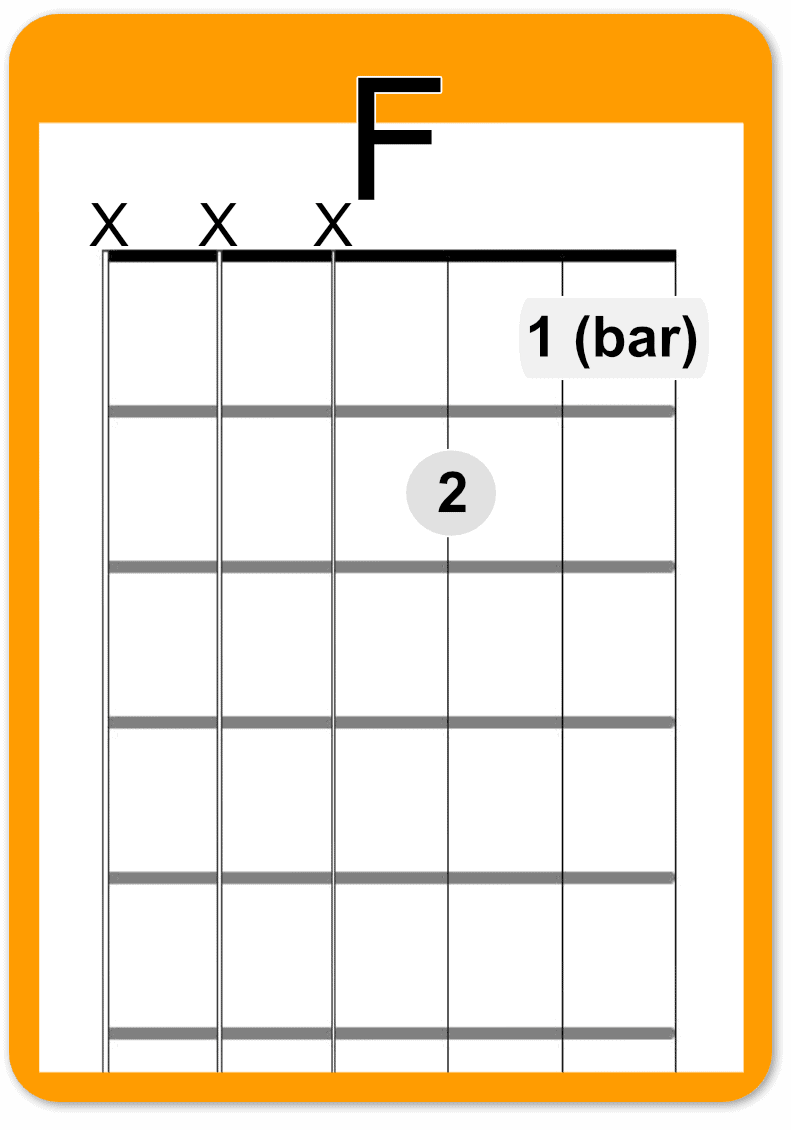
I start by teaching a simple two finger, three string version of the F chord. Consider this the first rung on the ladder.
Sometimes students rush through this first step in a desire to advance more quickly. I encourage you to take your time on this first rung and get comfortable with it.
Practice this first version by itself, as well as with other chords and in simple songs.
You may not realize it at first but the practice you put on this first step will pay off many times over.
I go on to explain all the steps in this lesson including how to play the full bar chord version of the F. My intention is that you spend time on each of the steps before moving on to the next.
A great free resource that will help greatly is my Chord Mastery Checklist.
There I give you a clear step-by-step checklist to have at your fingertips as you go through mastering this or any chord.
You can access that at this button below…
Okay… With that said it's time for you to watch the video lesson on Mastering the F Chord...
Summary Of The Steps
The 2 Note Partial Bar
Start with the first two strings on the first fret using your first finger. This is the most difficult part.
Collapse the first knuckle and push the second higher into the air (see image below).
Pluck each of the strings with the right hand to see how clear they sound.
There’s a tendency to try to make it sound better by pressing harder.
Instead try adjusting the angle of the hand and moving the first finger closer to the first fret (not on top of it).
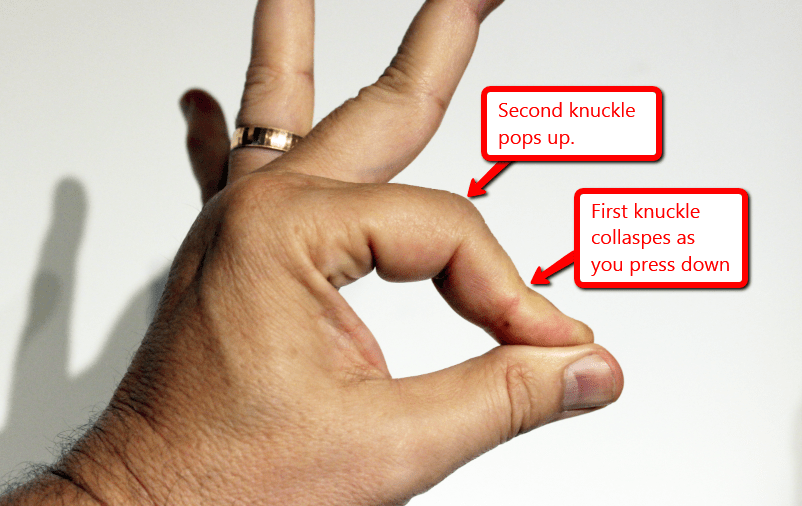
It’s a balance of the right position and just enough pressure to make them sound good. If you use only more pressure your hand will get tired very quickly.
Add The Second Finger to Make A Three Note Chord
The next step is to add your second finger on the third string, second fret.
Many students find when they add the second finger that it touches the second string.
If this happens just keep making small adjustments until it sounds good.
Practice Changing To Another Chord
After spending time forming and adjusting the three note F chord it’s time to work at changing to another chord.
I often recommend the C chord as a good chord to start with.
Practice changing from the three note F chord to a C chord. It's a good way to get accustomed to fingering the three note F chord over and over.
Also the C chord is a common chord to use with the F chord.
At this point it’s helpful to find other ways to use this chord such as simple songs and additional exercises.
Once you are fairly comfortable with this you can move on to adding another finger.
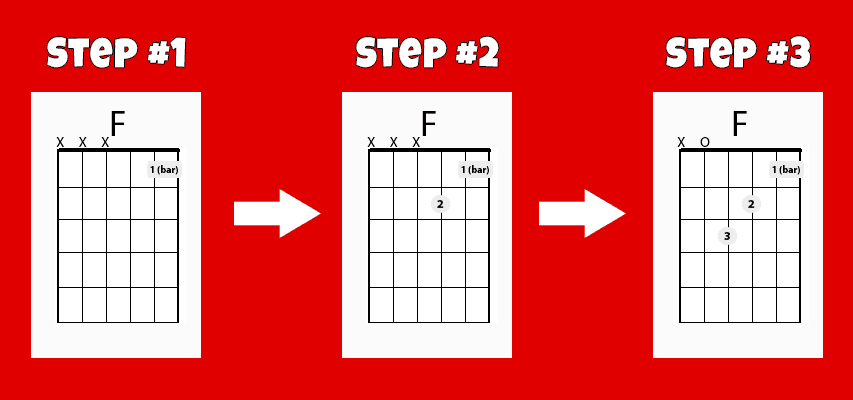
Four String Partial Bar F Chord
Now add the third finger on the fourth string, third fret.
Most people find this a fairly small leap after working on the three note form.
Go through the process we did in the previous step again to get comfortable with this new addition.
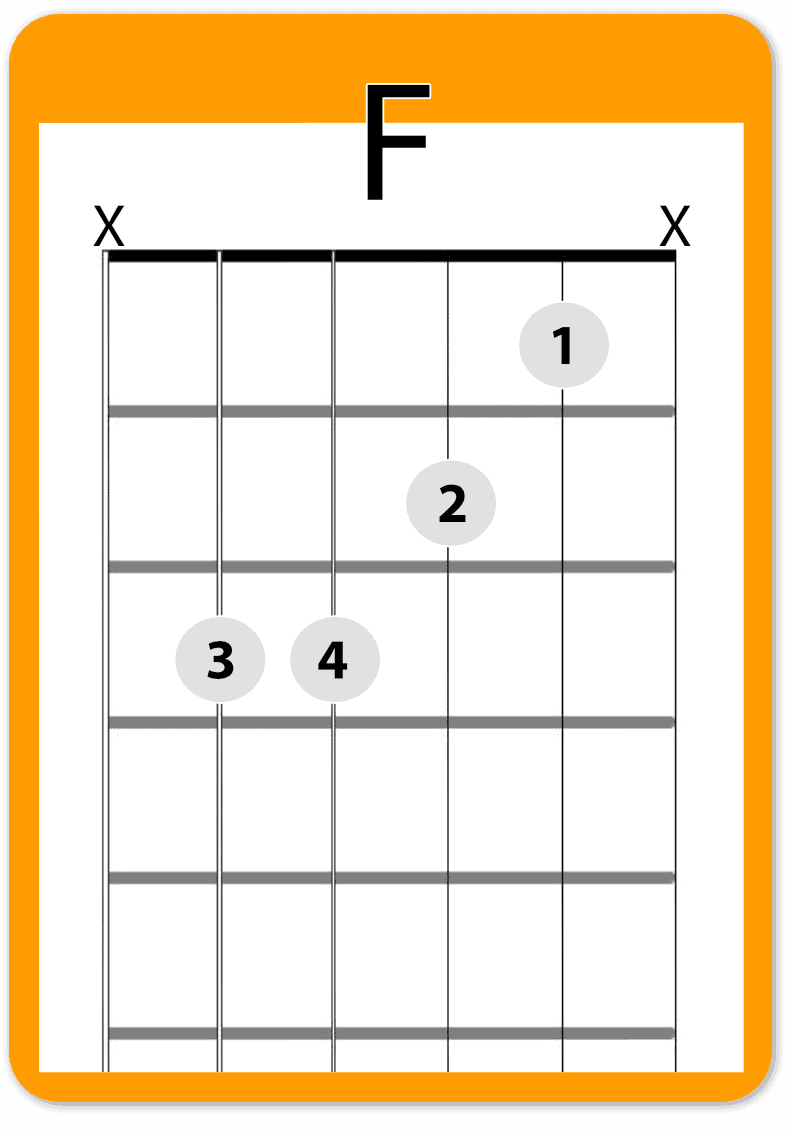
Bar Chord Exercise
Before playing the full bar F chord practice at least one of the Bar Chord Exercises.
This will not only help with the F barre chord but with barre chords in general.
In the video below there are three exercises. I recommend you start with the first or second exercise.
Start including this in your practice sessions while you're still working on the partial bar F chord. Perhaps spend a few minutes each day.
You can work up to all three exercises, but don't stress over it. You can always come back and learn the other exercises later.
Full Bar F Chord
The last step is to make the full bar chord. Finger the full bar chord and check to see that all the notes are sounding.
Once you've done this for a little while go through some of the same exercises you did with the partial bar version.
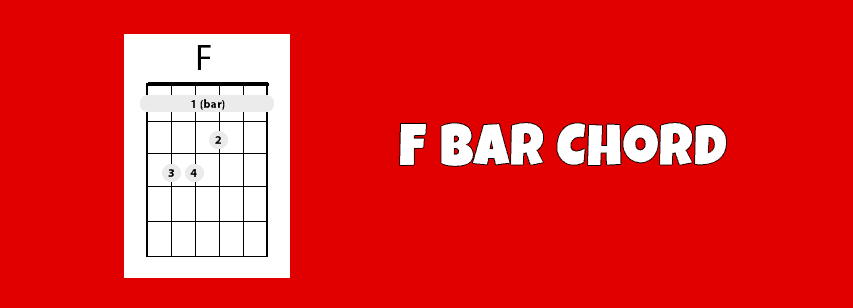
Additional Practice Help
To help with practicing the F chord I've created a 5-Minute Practice Session that many students find invaluable.
First practice fingering the basic three note and four note chords. When you're ready practice along with the F Chord Practice Session below:
In this five-minute guitar practice session you're going to get a good intense workout on the F chord.
To get the most from these 5 minute practice sessions it’s best to practice them once or twice a day for a period of time.
Important: This is a practice session video and is not intended to teach you how to play the chords. It is a play-along video. Think of it as practicing with your teacher for five minutes.
Here are the chord diagrams for the chords I'm using in this session...
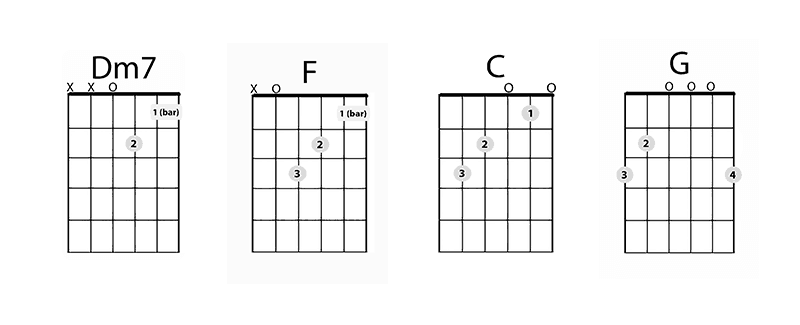
What If You Encounter Problems?
The two most likely problems you might encounter when starting out with the three finger form are...
1) The second string is buzzing, and
2) When you stretch your finger over the first two strings to play the third string it mutes the second string.
Know that these are common and most everybody encounters them in the beginning.
The solution in both cases is to just keep making small adjustments and practicing little by little.
It also helps to make sure your guitar action is adjusted properly. That means that the strings are the right distance from the neck for optimal playing.
Try not to get discouraged. Know that over time your fingers will get stronger.
You’ll also make small adjustments that will help the chord sound better and better. Practice and persistence.
Keep coming back at it.
Is There Another Way to Go?
Other Variations of the F Chord
I show several versions of the F chord in the video.
For most people the partial bar F chord is the best place to start.
It also is helpful to learn the “partial bar” technique because it will come in handy for other chord forms… like Em7(b5).
However, don't rule out starting off with the full bar chord. For some this is actually easier once they practice the bar itself.
It also opens the door more quickly to playing bar chords up and down the neck.
Keep in mind that you'll actually need all versions of this chord eventually and there's no wasted learning here no matter which one you decide to start on.
Final "F Chord" Notes
Don't be one of those people that avoid any song that uses the F chord. You can do this!
I’ve seen it over and over. Just keep at it a little at a time.
Sometimes your hand may feel a little sore... especially the muscle between your thumb and first finger.
Think of it like working out at the gym. Your muscles might get sore for one day, but after a few days of rest you're ready to go back at it.
Persistence is the key. Keep coming back at it a little bit each day.
If you need to take a rest because your hand is sore for a day or two that's okay, but get to it after that.
I’ve created a step-by-step checklist that will compliment this lesson (below). I’d encourage you to print it out and use it to guide your practice daily.
Feeling Stuck?
Frustrated by a lack of progress? If you're a RGS Academy member, check out the course Beginner's Journey where you'll go step-by-step through a guitar learning adventure that's guaranteed to give you real results.
Not a member yet? No problem. Sign up here FREE for 14 days. I’m hoping you stick around… but if not, the 2 weeks should be enough time to get the benefit from this lesson.
Tell Us What You Think - Please Comment Below!
We would love to hear your comments and questions. What specific things are you struggling with while learning guitar?

Thanks Tomas, I’ve added a slide show of my guitar shop at my website. Two projects underway, an Arch Top restoration and a Ramirez Flamenco 1909 replica. I practice your F chord and other lessons while waiting for glue to dry. Just click on the guitar icon at the bottom of the index page. Keep up the great work. 🙂
Mike
What a revelation! Thank you for this post.
Just did my first barre chord thank you so much
Hey Tom thanks fpr the tip, it really helped a lot. I had been strugling and trying to find a way to make it easy and your tips are awesome and simple to follow.
You’re very welcome Felix.
Tomas thank you so much. I an sixt nine years young and although I played guitar rather badly as a youth struggling with chord shapes Barr chords were a real challenge. You manner of d livery is refreshing. When I retired some eight plus years ago I elected to revisit my guitars and learn to prove. I was looking at the maxim ‘use it or loose it’. I genuinely wanted to achieve a degree of success. I purchased literally hundreds of pounds of books and DVD tutorial material. This I should add was after a fairly successful guitar course whereby the ‘teacher’ requested the newbies to tune their guitars and spent the rest of the evenings addressing his more accomplished ‘pupils’ . It was hopeless, thus my going down the online road. I have two totours in particular that I follow. One is called Griff Hamlin an American and Mike Herberts an English . They both send material on a regular basis along with selling loads of course material.
Often family commitments can impede the learning curve. I have the added angst in that I married into a very musical family. My wife, for instance played Bassoon in the National Youth Orchestra. My daughter plays grade eight piano and grade five flute. My father-n-law and brother-n-law played saxophone and clarinet for many years. My final reason for limited success is I do not take critics lightly and the last three mentioned can be inhibiting in their disquiet that I so many guitar. This is why I have never played before any of them; choosing to keep my playing private.
Keep up the great work. I look forward to revisiting your online tuition not least because you make it easy to follow.
Hi Alex,
Glad to be apart of your musical journey. Keep up the good work, and know we’re cheering you on!
– Aimee
Customer Care
Thanks Thomas. I have played guitar for 59+ years and taught for 54+ years. My students have always had problems with the F chord. So I usually have them use the F chord fingering way up the neck where the frets are closer together and then move on down to get to the first fret. Gradually over time most of them succeed in playing the F chord in the first position. The 10th position seems to be a good place to start.
That makes sense. Thanks for the tip Gordy.
– Tomas
me and my wife not long started playing guitar. and we would like to learn to play better. thank you.
Hi Wayne, if you are looking for some additional guitar help, check out my online guitar school at Real Guitar Success. https://www.realguitarsuccess.com
I have a trial membership (14 days for $1) where you and your wife can explore what I have to offer to see if it’s right for you!